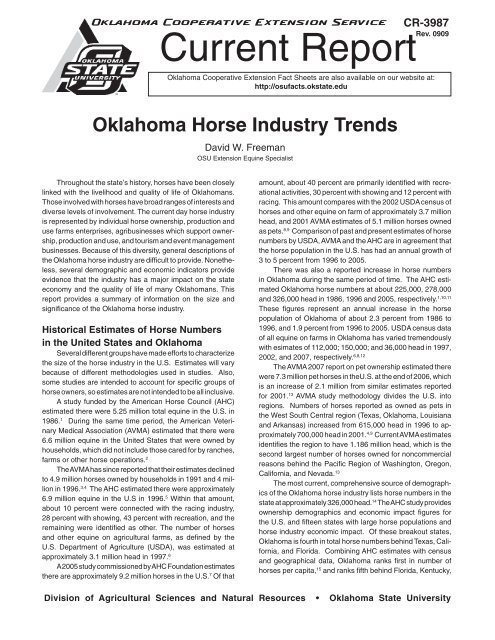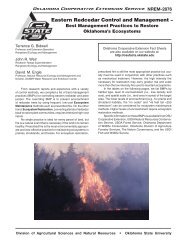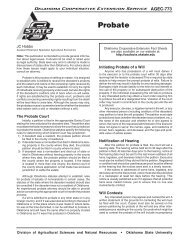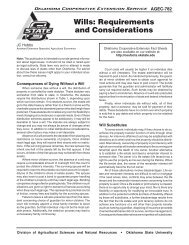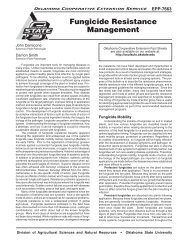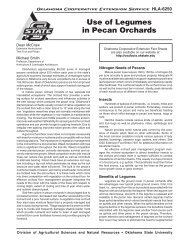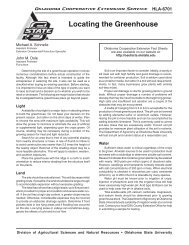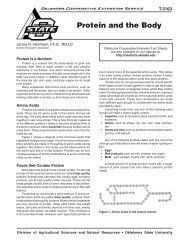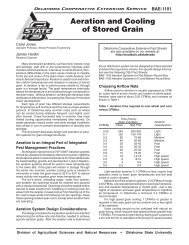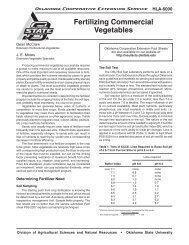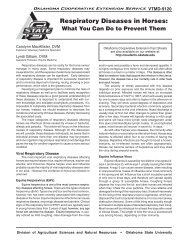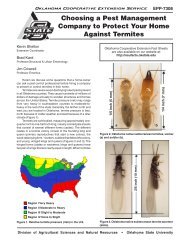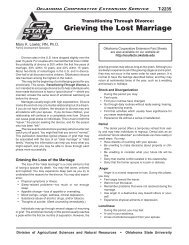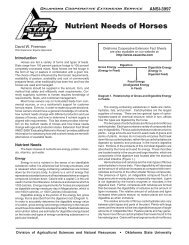Current Report - OSU Fact Sheets - Oklahoma State University
Current Report - OSU Fact Sheets - Oklahoma State University
Current Report - OSU Fact Sheets - Oklahoma State University
You also want an ePaper? Increase the reach of your titles
YUMPU automatically turns print PDFs into web optimized ePapers that Google loves.
<strong>Oklahoma</strong> Cooperative Extension Service CR-3987<br />
<strong>Current</strong> <strong>Report</strong><br />
Rev. 0909<br />
<strong>Oklahoma</strong> Cooperative Extension <strong>Fact</strong> <strong>Sheets</strong> are also available on our website at:<br />
http://osufacts.okstate.edu<br />
<strong>Oklahoma</strong> Horse Industry Trends<br />
David W. Freeman<br />
<strong>OSU</strong> Extension Equine Specialist<br />
Throughout the state’s history, horses have been closely<br />
linked with the livelihood and quality of life of <strong>Oklahoma</strong>ns.<br />
Those involved with horses have broad ranges of interests and<br />
diverse levels of involvement. The current day horse industry<br />
is represented by individual horse ownership, production and<br />
use farms enterprises, agribusinesses which support ownership,<br />
production and use, and tourism and event management<br />
businesses. Because of this diversity, general descriptions of<br />
the <strong>Oklahoma</strong> horse industry are difficult to provide. Nonetheless,<br />
several demographic and economic indicators provide<br />
evidence that the industry has a major impact on the state<br />
economy and the quality of life of many <strong>Oklahoma</strong>ns. This<br />
report provides a summary of information on the size and<br />
significance of the <strong>Oklahoma</strong> horse industry.<br />
Historical Estimates of Horse Numbers<br />
in the United <strong>State</strong>s and <strong>Oklahoma</strong><br />
Several different groups have made efforts to characterize<br />
the size of the horse industry in the U.S. Estimates will vary<br />
because of different methodologies used in studies. Also,<br />
some studies are intended to account for specific groups of<br />
horse owners, so estimates are not intended to be all inclusive.<br />
A study funded by the American Horse Council (AHC)<br />
estimated there were 5.25 million total equine in the U.S. in<br />
1986. 1 During the same time period, the American Veterinary<br />
Medical Association (AVMA) estimated that there were<br />
6.6 million equine in the United <strong>State</strong>s that were owned by<br />
households, which did not include those cared for by ranches,<br />
farms or other horse operations. 2<br />
The AVMA has since reported that their estimates declined<br />
to 4.9 million horses owned by households in 1991 and 4 million<br />
in 1996. 3,4 The AHC estimated there were approximately<br />
6.9 million equine in the U.S in 1996. 5 Within that amount,<br />
about 10 percent were connected with the racing industry,<br />
28 percent with showing, 43 percent with recreation, and the<br />
remaining were identified as other. The number of horses<br />
and other equine on agricultural farms, as defined by the<br />
U.S. Department of Agriculture (USDA), was estimated at<br />
approximately 3.1 million head in 1997. 6<br />
A 2005 study commissioned by AHC Foundation estimates<br />
there are approximately 9.2 million horses in the U.S. 7 Of that<br />
amount, about 40 percent are primarily identified with recreational<br />
activities, 30 percent with showing and 12 percent with<br />
racing. This amount compares with the 2002 USDA census of<br />
horses and other equine on farm of approximately 3.7 million<br />
head, and 2001 AVMA estimates of 5.1 million horses owned<br />
as pets. 8,9 Comparison of past and present estimates of horse<br />
numbers by USDA, AVMA and the AHC are in agreement that<br />
the horse population in the U.S. has had an annual growth of<br />
3 to 5 percent from 1996 to 2005.<br />
There was also a reported increase in horse numbers<br />
in <strong>Oklahoma</strong> during the same period of time. The AHC estimated<br />
<strong>Oklahoma</strong> horse numbers at about 225,000, 278,000<br />
and 326,000 head in 1986, 1996 and 2005, respectively. 1,10,11<br />
These figures represent an annual increase in the horse<br />
population of <strong>Oklahoma</strong> of about 2.3 percent from 1986 to<br />
1996, and 1.9 percent from 1996 to 2005. USDA census data<br />
of all equine on farms in <strong>Oklahoma</strong> has varied tremendously<br />
with esimates of 112,000; 150,000; and 36,000 head in 1997,<br />
2002, and 2007, respectively. 6,8,12<br />
The AVMA 2007 report on pet ownership estimated there<br />
were 7.3 million pet horses in theU.S. at the end of 2006, which<br />
is an increase of 2.1 million from similar estimates reported<br />
for 2001. 13 AVMA study methodology divides the U.S. into<br />
regions. Numbers of horses reported as owned as pets in<br />
the West South Central region (Texas, <strong>Oklahoma</strong>, Louisiana<br />
and Arkansas) increased from 615,000 head in 1996 to approximately<br />
700,000 head in 2001. 4,9 <strong>Current</strong> AVMA estimates<br />
identifies the region to have 1.186 million head, which is the<br />
second largest number of horses owned for noncommercial<br />
reasons behind the Pacific Region of Washington, Oregon,<br />
California, and Nevada. 13<br />
The most current, comprehensive source of demographics<br />
of the <strong>Oklahoma</strong> horse industry lists horse numbers in the<br />
state at approximately 326,000 head. 14 The AHC study provides<br />
ownership demographics and economic impact figures for<br />
the U.S. and fifteen states with large horse populations and<br />
horse industry economic impact. Of these breakout states,<br />
<strong>Oklahoma</strong> is fourth in total horse numbers behind Texas, California,<br />
and Florida. Combining AHC estimates with census<br />
and geographical data, <strong>Oklahoma</strong> ranks first in number of<br />
horses per capita, 15 and ranks fifth behind Florida, Kentucky,<br />
Division of Agricultural Sciences and Natural Resources • <strong>Oklahoma</strong> <strong>State</strong> <strong>University</strong>
Ohio, and Indiana in number of horses per square mile.<br />
Most horse breeds characteristic to the United <strong>State</strong>s can<br />
be found in <strong>Oklahoma</strong>. As a percentage of the total numbers<br />
of horses, predominant breeds in <strong>Oklahoma</strong> are the Quarter<br />
Horse, various stock color breeds, and the Thoroughbred.<br />
The American Quarter Horse Association and AHC estimate<br />
about 191,000 head of Quarter Horses were in <strong>Oklahoma</strong><br />
in 2005. 14,16 This represents almost 60 percent of the total<br />
<strong>Oklahoma</strong> horse population. Thoroughbreds represent about<br />
7 percent, and other horses, including registered and unregistered<br />
horses account for the remaining 34 percent. 14<br />
The size and diversity of the state’s horse population is<br />
evidenced by the number of active state-level associations<br />
representing ownership of numerous breeds of ponies, pleasure-type<br />
horses, stock-type horses, donkeys, mules, and draft<br />
horses. Although many breeds represent a smaller percentage<br />
of the total horse numbers, many can provide examples of<br />
nationally-recognized, <strong>Oklahoma</strong>-based production and use<br />
enterprises.<br />
Characterizing <strong>Oklahoma</strong> Horse Industry<br />
Interests<br />
The horse industry involves an interrelationship of private<br />
horse owners, commercial production, use and support enterprises<br />
serving horse owners, and spectator oriented events<br />
and activities. People own horses for a variety of hobby and<br />
business interests. <strong>Oklahoma</strong>ns list pleasure and enjoyment,<br />
competition, youth development, and a variety of business uses<br />
as reasons for owning horses. 17 Types of horse operations<br />
in <strong>Oklahoma</strong> include breeding farms, suburban residences,<br />
boarding stables, training and breeding facilities, and small<br />
to large acreage farms and ranches.<br />
Commercial horse enterprises include breeding farms,<br />
training farms, boarding stables, camp and trail ride<br />
businesses, horse sales, and a host of affiliated enterprises.<br />
Horse Owners<br />
The AVMA estimated that 2.6 percent of the households<br />
in the West South Region of the U.S. owned horses for noncommercial<br />
uses in 2006. 13 The AVMA further estimated that<br />
on a national level, about 35 percent of the horse-owning<br />
households owned one horse, about 40 percent owned two<br />
to three horses, and 25 percent owned four or more horses.<br />
The AHC estimates that 60,929 <strong>Oklahoma</strong>ns over the<br />
age of eighteen own horses, with a total of 117,886 people<br />
participating as owners, family members and volunteers, or<br />
employees of horse industry enterprises in the state. 14 The<br />
AHC estimates of horse owners and horse numbers suggest<br />
an average of five head per owner.<br />
County-level surveys have provided similar estimates<br />
on the average number of horses owned; however, there are<br />
actually two large groups of horse owners in <strong>Oklahoma</strong>. 17<br />
Those owners involved with horses for hobby average about<br />
three to four head. Those who indicate horse ownership as<br />
part of a horse business average about 15 head per owner.<br />
These averages represent large ranges in numbers of horses<br />
owned for both hobby and business purposes.<br />
As with horse numbers, the amount of investment horse<br />
owners have in horse operations varies between those involved<br />
for business and hobby reasons. A 1992 study comparing<br />
horse activities in two different counties in <strong>Oklahoma</strong> suggested<br />
average investment of facilities, capital equipment,<br />
and special tools and supplies in horse businesses to be<br />
about $80,000 per owner. 17 Those owners involved for hobby<br />
interests indicated investments at about $20,000 per owner.<br />
These averages do not include land as horse investment, and<br />
averages represent wide ranges. As a case in point, more<br />
recent surveys of racehorse owners suggest average levels of<br />
investment in horses, land, and facilities of around $220,000<br />
per owner. 18<br />
Estimates of annual costs of owning horses characterize<br />
the economic activity of horse ownership. Ownership and<br />
operating costs of owning one horse for hobby was estimated<br />
at $2,000 annually in a study conducted in 1993. 17,19 This<br />
estimate does not include labor, travel, and use expenses<br />
and would be influenced by differences in number of horses<br />
owned and amount of horse use.<br />
Commercial Enterprises<br />
Commercial horse enterprises include breeding farms,<br />
training farms, boarding stables, camp and trail-ride businesses,<br />
horse sales, and a host of affiliated enterprises.<br />
The horse production industry is large, diverse, and<br />
sectionalized. As such, there is a large range in owner costs<br />
and investments. The annual cost of maintaining a broodmare<br />
in commercial production was estimated at about $3,500 in<br />
1989. 20 This estimate included operating and fixed costs such<br />
as sale fees of offspring, feed, health care, labor, equipment<br />
repairs, and interest and depreciation on capital assets. This<br />
cost did not include breeding fees. The same study estimated<br />
that between $5,000 and $6,000 was necessary to cover the<br />
cost of yearling production in 1989.<br />
Many nationally recognized training centers for show<br />
and racehorses are based in <strong>Oklahoma</strong>. <strong>State</strong>-based affiliated<br />
industries such as trailer manufacturing businesses,<br />
tack and clothing manufacturing businesses, and agricultural<br />
CR-3987.2
of $1.2 billion. 11 The contributions of showing and recreation<br />
activities each account for about 30 percent of this estimate,<br />
racing 15 percent, with the remaining 25 percent attributed to<br />
other activities.<br />
Calendar year 2007 was the twenty-fourth year of parimutuel<br />
racing in <strong>Oklahoma</strong> with four sanctioned parimutuel<br />
racetracks conducting 198,849 official races<br />
including 196,218 simulcast races.<br />
enterprises (e.g., feed manufacturing) represent significant<br />
levels of investments and economic activity directly related<br />
to horse production and ownership.<br />
Horse Racing Industry<br />
Estimates on the 1993 <strong>Oklahoma</strong> race industry suggest<br />
about 3,700 <strong>Oklahoma</strong>ns owned 42,000 horses used for<br />
racing or racehorse production. 18 These owners averaged<br />
about $250,000 in land, building, facility, equipment, and<br />
horse investments. The same study suggested about 1850<br />
<strong>Oklahoma</strong>-based racehorse trainers had average investments<br />
of $183,000 in land, facilities, machinery, tack, and<br />
horses in their horse training enterprises. Calendar year<br />
2007 was the twenty-fourth year of pari-mutuel racing in<br />
<strong>Oklahoma</strong> with four sanctioned pari-mutuel racetracks conducting<br />
198,849 official races including 196,218 simulcast<br />
races. 21<br />
Spectator and Horse Use Events<br />
Numerous communities, state, regional, national, and<br />
world-level horse events are held annually across <strong>Oklahoma</strong>.<br />
Events such as horse shows, horse races, rodeos, and<br />
trail rides contribute significantly to the economies of many<br />
<strong>Oklahoma</strong> communities. The estimated economic impact of<br />
fifteen of the national and world level horse shows held in<br />
<strong>Oklahoma</strong> City alone is more than $100 million annually. 22<br />
The economic impact of equine activities is so significant<br />
that many communities have large investments in horse-use<br />
facilities. Even smaller, area-wide events such as community<br />
rodeos and local horse shows provide significant economic<br />
input to many areas in <strong>Oklahoma</strong>.<br />
Estimates of Economic Impact<br />
According to a 2004 AHC study, the gross domestic<br />
product produced from the <strong>Oklahoma</strong> horse industry accounts<br />
for a combined direct, indirect, and induced effect<br />
Trends in the Horse Industry<br />
One of the main reasons for interest in the horse industry is<br />
that it is a tool to improve the quality of human life. The horse<br />
is a model animal for people to use in leisure activities and use<br />
as a youth educational tool. Households with children are most<br />
likely to own horses. 13<br />
Numerous state-level breed and sport associations have<br />
large membership lists and are continually attracting new members.<br />
The number and level of activities of associations catering<br />
to specific sports, such as reining, has increased. Breed associations<br />
have documented an increased interest among novice<br />
and amateur competitors, and are expanding their emphasis to<br />
promote non-arena activities such as pleasure riding and trail<br />
riding.<br />
Changes in incentive programs which have increased purse<br />
supplements and breeders awards, and state laws legalizing<br />
simulcasting and off-track betting have influenced racehorse<br />
production, use, and race track activities.<br />
<strong>Oklahoma</strong> has a reputation for being a national center for<br />
horse activities. It is a leading state in stock horse production,<br />
and has numerous commercial horse enterprises including sale<br />
facilities, trailer manufacturers, and feed milling businesses.<br />
<strong>Oklahoma</strong> is the site for numerous show competitions which<br />
draws exhibitors and spectators from around the world. It is<br />
unique for a state to have this level of activity in all sectors of<br />
the horse industry.<br />
The <strong>Oklahoma</strong> horse industry’s economic impact and distribution<br />
of horse numbers across the state is largely unquantified.<br />
Horse owners, city and state level public officials, and<br />
private businesses routinely request information on the state’s<br />
or a particular locality’s horse industry. Continued efforts are<br />
needed to gather information that would assist the economic<br />
growth and development of one of the largest industries in the<br />
state.<br />
Many <strong>Oklahoma</strong>ns enjoy recreation through leisure activities<br />
involving horses.<br />
CR-3987.3
References<br />
1. The Economic Impact of the United <strong>State</strong>s Horse Industry,<br />
The American Horse Council, Washington D.C., 1986.<br />
2. United <strong>State</strong>s Pet Ownership and Demographic Source<br />
Book, American Veterinary Medical Association, 1987.<br />
3. United <strong>State</strong>s Pet Ownership and Demographic Source<br />
Book, American Veterinary Medical Association, 1992.<br />
4. United <strong>State</strong>s Pet Ownership and Demographic Source<br />
Book, American Veterinary Medical Association, 1997.<br />
5. The Economic Impact of the Horse Industry in the United<br />
<strong>State</strong>s. Vol. 1: National Summary, American Horse<br />
Council, 1997.<br />
6. Census of Agriculture, United <strong>State</strong>s Data. National<br />
Agricultural Statistics Service, USDA, 1997<br />
7. The Economic Impact of the Horse Industry in the United<br />
<strong>State</strong>s. American Horse Council Foundation, 1996.<br />
8. Census of Agriculture, United <strong>State</strong>s Data. National<br />
Agricultural Statistics Service, USDA, 2002<br />
9. United <strong>State</strong>s Pet Ownership and Demographic Source<br />
Book, American Veterinary Medical Association, 2002.<br />
10. The Economic Impact of the Horse Industry in the United<br />
<strong>State</strong>s. Vol 2: Estimates for Eleven Focus <strong>State</strong>s, American<br />
Horse Council, 1997.<br />
11. The Economic Impact of the <strong>Oklahoma</strong> Horse Industry.<br />
American Horse Council Foundation, 2005.<br />
12. Census of Agriculture, United <strong>State</strong>s Data. National<br />
Agricultural Statistics Service, USDA, 2007.<br />
13. United <strong>State</strong>s Pet Ownership and Demographic Source<br />
Book, American Veterinary Medical Association, 2007.<br />
14. The Economic Impact of the <strong>Oklahoma</strong> Horse Industry.<br />
American Horse Council Foundation, 2005.<br />
15. Population estimates from the U.S. Bureau of Census,<br />
2002.<br />
16. 2004 Annual <strong>Report</strong>, American Quarter Horse Association.<br />
17. A Description and Analysis of Characteristics Affecting<br />
Decision Making Behavior of Horse Farm Managers,<br />
Masters thesis by L.A. Elliot, <strong>Oklahoma</strong> <strong>State</strong> <strong>University</strong>,<br />
1993.<br />
18. Demographics and Economic Impact of the Horse Racing<br />
Industry in <strong>Oklahoma</strong>. <strong>OSU</strong> <strong>Current</strong> <strong>Report</strong> CR-3918,<br />
1997.<br />
19. First Time Horse Ownership: Selecting Horses and<br />
Budgeting Horse Interests, <strong>OSU</strong> <strong>Fact</strong> Sheet ANSI-4004,<br />
1994.<br />
20. Economic Analysis of Selected Horse Production Systems<br />
in <strong>Oklahoma</strong>, OAES Research <strong>Report</strong> P-905, Department<br />
of Agricultural Economics, <strong>Oklahoma</strong> <strong>State</strong> <strong>University</strong>,<br />
1989.<br />
21. <strong>Oklahoma</strong> Horse Racing Commission Annual <strong>Report</strong>,<br />
2007.<br />
22. <strong>Oklahoma</strong> City Chamber of Commerce estimates using<br />
estimated dollars spent times number of event participants<br />
times days of the activity.<br />
<strong>Oklahoma</strong> <strong>State</strong> <strong>University</strong>, in compliance with Title VI and VII of the Civil Rights Act of 1964, Executive Order 11246 as amended, Title IX of the Education Amendments of 1972, Americans<br />
with Disabilities Act of 1990, and other federal laws and regulations, does not discriminate on the basis of race, color, national origin, gender, age, religion, disability, or status as a veteran in<br />
any of its policies, practices, or procedures. This includes but is not limited to admissions, employment, financial aid, and educational services.<br />
Issued in furtherance of Cooperative Extension work, acts of May 8 and June 30, 1914, in cooperation with the U.S. Department of Agriculture, Robert E. Whitson, Director of Cooperative<br />
Extension Service, <strong>Oklahoma</strong> <strong>State</strong> <strong>University</strong>, Stillwater, <strong>Oklahoma</strong>. This publication is printed and issued by <strong>Oklahoma</strong> <strong>State</strong> <strong>University</strong> as authorized by the Vice President, Dean, and Director<br />
of the Division of Agricultural Sciences and Natural Resources and has been prepared and distributed at a cost of 20 cents per copy. Revised 0909 GH.<br />
CR-3987.4


